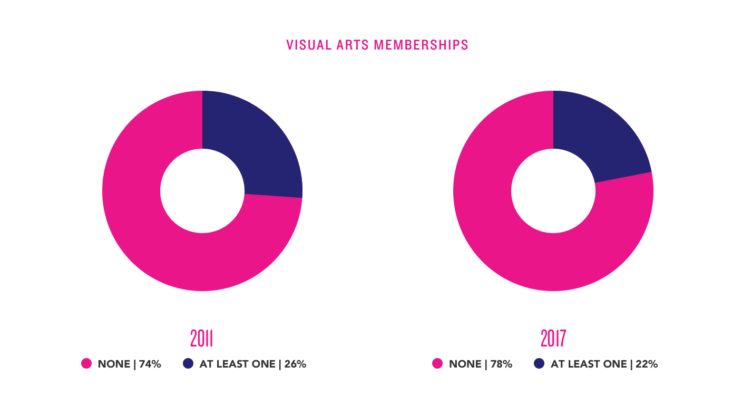4 Important Membership Trends Every Museum Needs to Consider

It’s 2019, and a whole lot is changing in the museum and nonprofit world. Organizations need to determine how they fit into the transforming digital landscape and anticipate the changing expectations of their visitor and member base. Looking to the present and the future, here are four big trends to take notice of to ensure the ongoing success of your membership operation.
1. Rising Costs of Membership (and Everything)
Year after year, the cost of everything continues to rise, and this has serious implications when it comes to thinking about budgeting and efficiency. Between the costs of labor, facility maintenance, and regular operations, organizations are fighting to keep their heads above water. The importance of smarter planning and strategic thinking is more vital than it has ever been when it comes to how dollars are allocated and spent.
Running a successful membership program involves lots of moving parts, which can come at a cost. From hosting special member events to fulfilling membership cards to all related marketing, mailings, and collateral, everything adds up fast!
Traditional membership programs issue paper/plastic cards and use a combination of direct mail and email marketing to reach their constituents. Both physical membership cards and snail mail marketing materials can be taxing for these organizations. Just this year, postage has increased from 50 cents to 55 cents for First Class mail. Nonprofits have already expressed concern about the effect of this hike on fundraising. When it comes to mass direct-mail campaigns, that difference of 5 cents can accumulate quickly for organizations on a tight budget!
That’s not to mention how strained museums already are in terms of resources. According to the American Alliance of Museums, the average museum has 6 volunteers for every paid staff member, a ratio which soars to 18:1 in museums with budgets under $250,000. Heavily reliant on volunteer labor as it is, museums cannot afford to squander valuable staff resources on membership tasks like envelope stuffing.
Adding to this equation, more museums are starting to unionize. Unionizing grants more power to the workers, but it also drives up the cost of staff labor. Just last month, the New Museum’s newly formed union was busy negotiating a contract and the Guggenheim museum workers voted to unionize as well. This is sure to accelerate the trend towards unionization and overall salary equality.
With these increasing costs, museums need to be smarter with where they direct their dollars. Innovating membership by introducing digital membership cards is just one small step in efforts to save on staff labor, time, and money.
Pro Tip: You can figure out just how much you can save by plugging a few simple numbers into this calculator!
2. Rapid Shifts in Consumer Expectations
The rise of mobile technology has also led to changes in consumer expectations and demands. It’s not just major brands that have to cater to modern consumers – museums and nonprofits also need to anticipate the needs of an increasingly mobile-oriented audience. 45% of Millennials said technology has made them more impatient than they were five years ago, and all consumers are demanding instant gratification through seamless consumer experiences, especially in the age of the smartphone.
In today’s world, 59% of customers say companies need cutting-edge digital experiences to keep their business. But a lot of organizations are failing to keep up with these digital demands. According to Forbes, although 60% of companies think they’re providing a good mobile experience, only 22% of consumers feel the same. That’s a huge disconnect!
And while some organizations are taking their first steps into the digital revolution, 47% of companies haven’t started their digital transformation yet – while 59% are worried that it might already be too late for them. It’s not too late for museums and cultural organizations, but the longer you wait to introduce digital offerings to your members, the more you stand to lose.
80% of customers say that the experience a company provides is as important as its products or services, and organizations have to think hard about what that means for their membership program. It’s not enough to offer super-slick events or an out-of-this world tour through your exhibitions or galleries – museums also need to step up the membership experience by providing members with digital convenience.
According to the Blackbaud Institute’s 2018 Charitable Giving Report, “In 2018, an estimated 24% of online transactions were made using mobile devices. This has grown steadily since 2014, and even higher rates occur for event registration and membership purchases.” What’s more, the report also urges that “Every nonprofit organization needs to understand that being mobile friendly is linked to being donor friendly. This is no longer optional, and a lack of mobile friendly websites, donation forms, and emails will put nonprofits at a distinct disadvantage.” As you can see, the impact of mobile and digital convenience on your members is already here, and it will only continue to grow.

Source: Blackbaud
Offering your members digital cards is just one way to stay on top of these mobile consumer trends. Digital membership cards can be downloaded and instantly added to your members’ digital wallets, ensuring a no-hassle membership experience!
Read more about retaining members: 7 Ways for Arts & Cultural Organizations to Retain Members
3. Increasingly Eco-Conscious Audiences
Corporate social responsibility is a buzzword these days, and that’s for good reason. According to Nielsen, 81% of global respondents feel strongly that companies should help improve the environment. A whopping 90% of millennials will buy from a brand whose social and environmental practices they trust, and almost half of U.S. shoppers say they’ll change their consumption habits to benefit the environment.
This trend is only likely to increase as Gen Z consumers come of age. The teens coming into adulthood are more likely than adults (57% vs. 49%) to pay more for brands that support the causes or organizations important to them.
In a nutshell, your members and visitors want you to go green, and they’ll take their spending power and focus elsewhere if you don’t make green practices a core part of your mission. With these numbers, museums and nonprofits simply cannot afford to ignore delivering on their commitment to the environment.
If you want to keep up, you have to go green! Digital membership cards eliminate the paper and plastic associated with physical membership cards. Moreover, the back of the digital card can be used to advertise special events, and the card allows museums to send membership renewal reminders directly to members’ mobile devices. These push notifications can drastically reduce the amount of paper waste from direct mailings. All in all, digital membership cards are a key way that museums can incorporate eco-friendly values into their practices and keep their eco-conscious members happy!
4. Competition for Loyalty
There is growing competition for attention, dollars, and loyalty from today’s consumer, whether altruistic nonprofit devotee, environmental advocate, culture vulture, or none of the above. According to La Placa Cohen’s 2017 Culture Track study, a leading resource on trends in the cultural sector, there has been a flat or downward trend in memberships and subscriptions. In 2011, 26% of people had at least one visual arts membership. That dropped to 22% by 2017. Additionally, a study by Museum Hack revealed that most museums see renewal rates between 50% and 79%. At a rate of 50% retention, a museum could turn over its entire member base in a matter of years!

If museums want to hold onto their members, they must recognize that the competition for member loyalty is tougher than ever and step up their game accordingly.
For example, the New England Museum Association Membership Survey uncovered that 67% of Museums use both email and mail to contact members to remind them to renew their membership. If most museums are still relying exclusively on mail and email for their marketing campaigns, they’re missing out on just how effective push notifications, social media, text messages or other innovative digital channels can be. For push notifications alone, not only is the messaging shorter and punchier – they also have a higher click through rate than email.
When competing for member loyalty, one of the greatest benefits you can offer is convenience. Children’s museums, science museums, natural history museums, zoos, and aquariums – all organizations directed towards families – should take special note. Parents are 21% more likely than non-parents to join a loyalty program that simplifies their planning and 31% more likely to join if organizations provide follow-up information so they can easily stay involved.
Digital membership cards are a great way to simplify logistics for busy parents and can be a medium to deliver them up to date information. Family memberships bring in lots of revenue, so it’s important to make them as user-friendly as possible in order to retain and acquire members.
Membership trends will continue to evolve, and as they do, it’s important to take small steps to transform your museum or nonprofit into smarter, more forward-thinking, and digital-savvy organization. How is your organization staying ahead?
